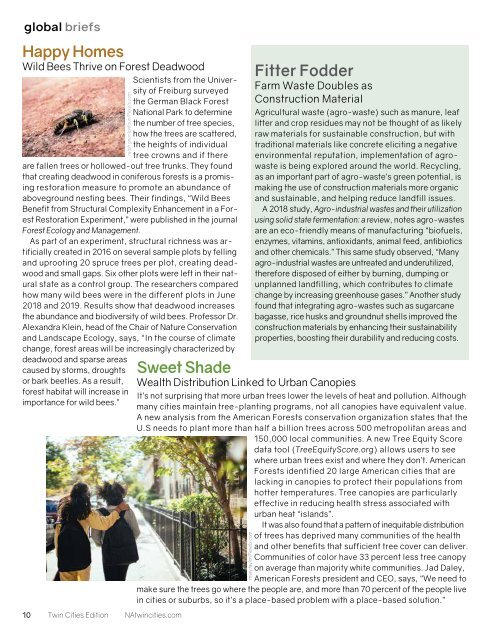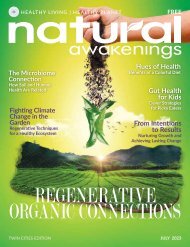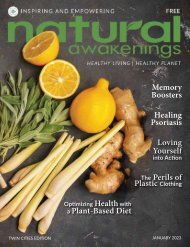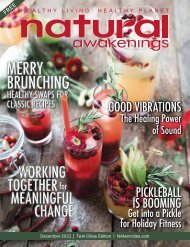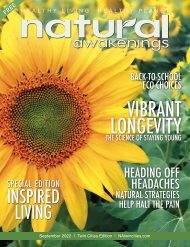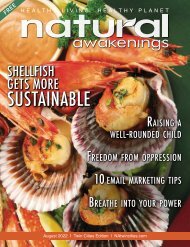Natural Awakenings Twin Cities September 2021
Read the September 2021 edition of Natural Awakenings Twin Cities magazine. This is our annual Inspired Living Issue which is focused on Creativity in Health and Healing and Integrative Pain Management. Topics also include the power of the written word, finding pain relief in essential oils, natural approaches to combating opioid abuse, creative kids, and so much more! Be sure to check out our local content including News Briefs announcements, Community Resource Guide with providers throughout the metro who can meet your individual wellness needs, and all the happenings in the Calendar of Events. There is additional online-only content that can be found at NATwinCities.com. While you are there, be sure to sign up for our Newsletter and Digital Magazine and continue your reading with our archived articles from local experts.
Read the September 2021 edition of Natural Awakenings Twin Cities magazine. This is our annual Inspired Living Issue which is focused on Creativity in Health and Healing and Integrative Pain Management. Topics also include the power of the written word, finding pain relief in essential oils, natural approaches to combating opioid abuse, creative kids, and so much more!
Be sure to check out our local content including News Briefs announcements, Community Resource Guide with providers throughout the metro who can meet your individual wellness needs, and all the happenings in the Calendar of Events. There is additional online-only content that can be found at NATwinCities.com.
While you are there, be sure to sign up for our Newsletter and Digital Magazine and continue your reading with our archived articles from local experts.
You also want an ePaper? Increase the reach of your titles
YUMPU automatically turns print PDFs into web optimized ePapers that Google loves.
global briefs<br />
Happy Homes<br />
Wild Bees Thrive on Forest Deadwood<br />
10 <strong>Twin</strong> <strong>Cities</strong> Edition NAtwincities.com<br />
ralph gnonlonfoun/Pexels.com<br />
Scientists from the University<br />
of Freiburg surveyed<br />
the German Black Forest<br />
National Park to determine<br />
the number of tree species,<br />
how the trees are scattered,<br />
the heights of individual<br />
tree crowns and if there<br />
are fallen trees or hollowed-out tree trunks. They found<br />
that creating deadwood in coniferous forests is a promising<br />
restoration measure to promote an abundance of<br />
aboveground nesting bees. Their findings, “Wild Bees<br />
Benefit from Structural Complexity Enhancement in a Forest<br />
Restoration Experiment,” were published in the journal<br />
Forest Ecology and Management.<br />
As part of an experiment, structural richness was artificially<br />
created in 2016 on several sample plots by felling<br />
and uprooting 20 spruce trees per plot, creating deadwood<br />
and small gaps. Six other plots were left in their natural<br />
state as a control group. The researchers compared<br />
how many wild bees were in the different plots in June<br />
2018 and 2019. Results show that deadwood increases<br />
the abundance and biodiversity of wild bees. Professor Dr.<br />
Alexandra Klein, head of the Chair of Nature Conservation<br />
and Landscape Ecology, says, “In the course of climate<br />
change, forest areas will be increasingly characterized by<br />
deadwood and sparse areas<br />
caused by storms, droughts<br />
or bark beetles. As a result,<br />
forest habitat will increase in<br />
importance for wild bees.”<br />
Fitter Fodder<br />
Farm Waste Doubles as<br />
Construction Material<br />
Sweet Shade<br />
Wealth Distribution Linked to Urban Canopies<br />
Agricultural waste (agro-waste) such as manure, leaf<br />
litter and crop residues may not be thought of as likely<br />
raw materials for sustainable construction, but with<br />
traditional materials like concrete eliciting a negative<br />
environmental reputation, implementation of agrowaste<br />
is being explored around the world. Recycling,<br />
as an important part of agro-waste’s green potential, is<br />
making the use of construction materials more organic<br />
and sustainable, and helping reduce landfill issues.<br />
A 2018 study, Agro-industrial wastes and their utilization<br />
using solid state fermentation: a review, notes agro-wastes<br />
are an eco-friendly means of manufacturing “biofuels,<br />
enzymes, vitamins, antioxidants, animal feed, antibiotics<br />
and other chemicals.” This same study observed, “Many<br />
agro-industrial wastes are untreated and underutilized,<br />
therefore disposed of either by burning, dumping or<br />
unplanned landfilling, which contributes to climate<br />
change by increasing greenhouse gases.” Another study<br />
found that integrating agro-wastes such as sugarcane<br />
bagasse, rice husks and groundnut shells improved the<br />
construction materials by enhancing their sustainability<br />
properties, boosting their durability and reducing costs.<br />
It’s not surprising that more urban trees lower the levels of heat and pollution. Although<br />
many cities maintain tree-planting programs, not all canopies have equivalent value.<br />
A new analysis from the American Forests conservation organization states that the<br />
U.S needs to plant more than half a billion trees across 500 metropolitan areas and<br />
150,000 local communities. A new Tree Equity Score<br />
data tool (TreeEquityScore.org) allows users to see<br />
where urban trees exist and where they don’t. American<br />
Forests identified 20 large American cities that are<br />
lacking in canopies to protect their populations from<br />
hotter temperatures. Tree canopies are particularly<br />
effective in reducing health stress associated with<br />
urban heat “islands”.<br />
It was also found that a pattern of inequitable distribution<br />
of trees has deprived many communities of the health<br />
and other benefits that sufficient tree cover can deliver.<br />
Communities of color have 33 percent less tree canopy<br />
on average than majority white communities. Jad Daley,<br />
American Forests president and CEO, says, “We need to<br />
make sure the trees go where the people are, and more than 70 percent of the people live<br />
in cities or suburbs, so it’s a place-based problem with a place-based solution.”<br />
mary taylor/Pexels.com


